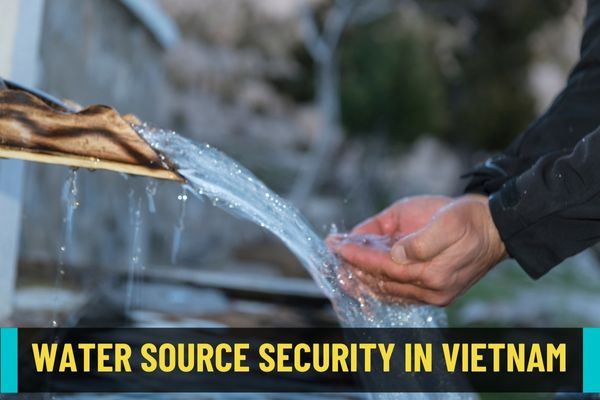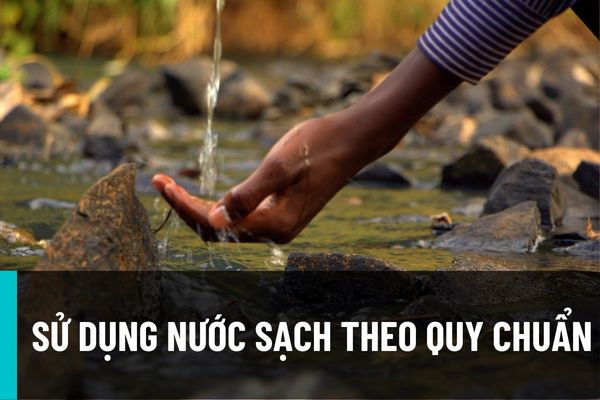By 2025, 95% of households in urban areas and 60% of households in rural areas will have access to clean water according to standards?
What is the situation of ensuring water source security in Vietnam and safety of dams and reservoirs?
According to Section I Conclusion 36-KL/TW in 2022 on ensuring water source security in Vietnam and safety of dams and reservoirs by 2030, with a vision to 2045 issued by the Central Committee as follows:
- Ensuring water source security in Vietnam and safety of dams and reservoirs is always concerned by the Party and State, leading and directing, achieving many positive results, basically meeting the requirements of socio-economic development. , ensuring national defense, security, people's life and activities.
- The legal system, mechanisms and policies on assurance of water source security in Vietnam, safety of dams and water reservoirs have been gradually improved; resources for investment in construction of water sector infrastructure are enhanced.
- Basic investigation and planning related to water sources are concerned.
- Inspection and examination of management, exploitation and use of water, discharge of wastewater into water sources, observance of the law on water resources, irrigation and natural disaster prevention and control are carried out regularly.
- International cooperation is expanded, especially with countries sharing water sources with Vietnam in exploiting, effectively and sustainably using transboundary water resources.
However, the work of ensuring water source security and safety of dams and reservoirs is still limited.
- Water resource management is still weak and ineffective; awareness and responsibility of many agencies, organizations, localities and people in the management, exploitation and use of water is not high; Water pollution is becoming more and more serious.
- The legal system, mechanisms and policies related to ensuring water source security and safety of dams and reservoirs is still lacking and inconsistent. Many irrigation works are degraded; Risks, unsafety of dams and reservoirs tend to increase.
- The development of industry and urban areas has not been associated with ensuring water source security, reducing the quantity and quality of water sources, even causing insecurity of water sources. International cooperation on ensuring water security is not very effective...
- The causes of the above-mentioned limitations and weaknesses are mainly due to: Awareness of a part of officials, party members and people about ensuring water source security, safety of dams, water reservoirs, protection, Inadequate water use.
- Vietnam is heavily dependent on water from upstream countries.
- State management is still inadequate and inconsistent; institutions and policies are slowly being revised, supplemented and perfected; not pay attention to water resource management, water resource economy; investment resources for ensuring water source security in Vietnam and safety of dams and reservoirs are mainly from the state budget, mobilizing social resources is still limited; sanctions to handle violations are not serious..

By 2025, 95% of households in urban areas and 60% of households in rural areas will have access to clean water according to standards? (Picture from internet)
What is the overall goal of ensuring water security and safety of dams and reservoirs?
According to Section II Conclusion 36-KL/TW in 2022 on ensuring water source security in Vietnam and safety of dams and reservoirs by 2030, with a vision to 2045 issued by the Central Committee as follows:
- Ensuring the quantity and quality of water for people's daily life in all situations; meet the demand for water use for production and business of all sectors and fields, especially important and essential economic sectors; All people, all subjects are entitled to access and use water fairly and reasonably.
- Actively storing and regulating water sources, exploiting and using efficiently in parallel with ensuring the safety of dams and reservoirs; effectively respond to disasters, water-related disasters, adapt to climate change; protect the environment, overcome the degradation, depletion and pollution of water sources.
What are the specific objectives of ensuring water security and safety of dams and reservoirs?
According to Section II Conclusion 36-KL/TW in 2022 on ensuring water source security and safety of dams and reservoirs by 2030, with a vision to 2045 issued by the Central Committee as follows:
- By 2025: Completing the formulation of national sectoral plannings, planning with specialized technical nature related to water;
+ 95% of households in urban areas and 60% of households in rural areas have access to clean water according to regulations;
+ To basically solve the shortage of water for daily life and production, especially in the provinces of the Mekong River Delta, the Central Highlands, the South Central Coast, and the Northern mountainous region;
+ To basically repair and upgrade to ensure the safety of dams and water reservoirs that are damaged, degraded, and not yet capable of fighting floods as designed.
- By 2030: To balance enough water to serve people's living and socio-economic development; 100% of households in urban areas and 80% of households in rural areas have access to clean water according to regulations.
+ To basically settle domestic water for densely populated islands; complete synchronously the system of works to regulate salt water, fresh water, water storage in large river basins; complete repair and upgrade of damaged, degraded dams and reservoirs with lack of capacity for flood prevention and control;
+ To initially overcome the situation of serious degradation and pollution of water sources in some river basins and large irrigation works systems; proactively prevent and combat natural disasters and adapt to climate change;
+ Build and operate a system to monitor, evaluate and supervise national water security according to international water management methods.
- By 2045: To take the initiative in water sources to serve the people's livelihood and socio-economic development; to ensure that rural households have access to clean water according to regulations; long-term forecasts and warnings to deal with pollution, degradation and depletion of water sources, response to natural disasters and climate change;
+ Control and overcome the situation of degradation and pollution of water sources in river basins and the system of irrigation works; perfecting the policy on water synchronously, unified interdisciplinary and inter-regional, ensuring water source security.
LawNet
